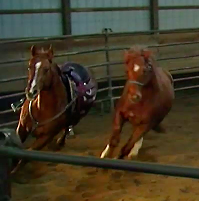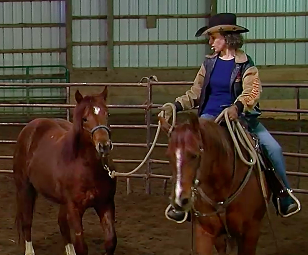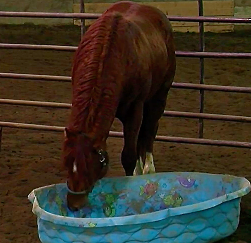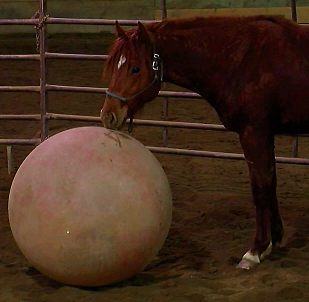I cover four topics in this episode; turning Jac out with Popcorn, ponying, round penning with a swimming pool and introducing the Weaver Activity Ball as a training tool.
- I work Jac and Popcorn together to emphasize to Jac that he must listen to and respect both Popcorn and Stacy at the same time. It also helps Jac know Popcorns boundaries before I mount up to pony.

- I ‘pony’ (lead Jac while mounted on Popcorn) to improve Jac’s leading and to prepare Jac for riding. Notice how reactive Jac was to my arm movements above his head. Can you see how this would help prepare the horse for a rider above them?

- Swimming Pool: Did you see how Jac was refusing to turn to his right when asked to move away from the swimming pool? It is important to recognize what has happened in the training the last few days to understand why things are happening. It would have been possible to see Jac’s ‘refusal’ to turn right (away from the pool) as a Jac being rotten…when in fact he was trying very, very hard to get to where he had been rewarded the last few days. Jac was wrong…but he was trying to please me.

- Ball: The main point of any of the objects (tarp, pool, ball) is explained here. The point isn’t exactly the object…it is that I can control his body. Watch after I move the ball to the other side of the round pen. Notice how I focus on inside turns and the ability to control Jac’s body. I show how to corrects a few wrong ‘outside’ turns.

The last one minute of this video, from 14:20 until the end, has a ton of information…watch closely because you can really see the conversation happening. In just a few more sessions you won’t be able to see the body language between us and it will look like magic….so feel free to re-watch this one!
17 Comments
Leave a Comment

FREE PDF DOWNLOAD
WHY IS MY HORSE...?
100% Private - 0% Spam
No one taught you the skills you need to work through these things.
Riders often encounter self-doubt, fear, anxiety, frustration, and other challenging emotions at the barn. The emotions coursing through your body can add clarity, or can make your cues indistinguishable for your horse.
Learning these skills and begin communicating clearly with your horse.
Click here to learn more.

[…] if you look back to Episode 14 you will see Jac questioning my leadership. When he thought the ‘ball’ was the answer he almost […]
Love your work with Jack. Love even more that you explain it from Jacks perspective. That’s huge!! Huge for people to understand what thier body language is saying to the horse. Also, huge for people to understand HORSE body language, how a horse would direct or communicate with another horse! Awesome!
[…] did some ‘free lunging’ in “Stacy’s Video Diary: Jac- Episode 14″. The lunging that most people speak against is done just to wear the horse out. Some people lunge […]
[…] myself, so the Jac series is wonderful!!! Thank you! I was wondering, why do you do this exercise? (Episode 14) What’s the reason for training the horse to go to a target? I’m not sure I exactly understand […]
Hi Stacy, my horse is two years old and I’m working on training her myself, so the Jac series is wonderful!!! Thank you! I was wondering, why do you do this exercise? What’s the reason for training the horse to go to a target? I’m not sure I exactly understand what you’re doing with this exercise.
Kailey-I turned your question into a blog! Check it out here.
Stacy,
I’ve been following Jac’s video series and am loving it. Thank you so much for sharing it!
I have a question about the inside turns: why is it so important to you that he turn to the inside instead of the outside? I have learned to turn to the outside and have trained my horses accordingly and am wondering whether I should retrain myself and them. In order to do that, I figure I need to understand the reasoning better.
I apologize in advance if you have discussed this somewhere. Just point me there in that case! 🙂
Thank you for being such an inspiration!
Best regards from Portugal,
Sandra
I used your question for a blog post: click here to read it!
Thanks, I’m flattered. 🙂
This is beautifully amazing! It’s really neat to realize that I am actually picking up on the interaction and cues (the conversation) and beginning to understand it. Thank you SO MUCH for sharing this information. What a blessing this series has been.
Thank you. This is a new way of thinking for me! I think (be in italics if I could!) I get it… and they need to be able to handle pressure because in the real world everything isn’t light and easy and trouble free for them, any more then it is for us! Will look forward to following Jac even more now… Thank you
Hi, I love all your work with horses, and am following the Jac series with enthusiasm! I have a question from this episode. I am English and I know its an American way of bitting a horse, but why has Popcorn got such long shanks (may not be correct term!) on his bit? To me this makes it look harsh, but I know from following your work that this wouldn’t be why he is wearing it. Would you ever ride him in a simple snaffle (I am currently a fan of the Myler bitting system for my youngsters and have them in comfort snaffles, and plan to keep them in these, maybe experimenting with ports to make more space and comfort for their tongues). I am just curious! Thanks.
Melinda
Melinda- The term ‘shank’ is correct. Popcorn was started in a snaffle as all my horses are. From that point on the horse begins to make choices. If they stay willing and soft in the snaffle then that is where we stay. Some do. Have you read my blog on spurs?
The reason I ask is because the changes in bit have more to do with the horses ‘attitude’ as an ’employee.’ As you mentioned Myler I bet you would enjoy the book or DVD http://mylerbitsusa.com/books_video.shtml which would explain a lot. I may have to write a blog about bits now, lol
Thank you Stacy! The article on spurs does make sense to me, I have not used spurs on my own horses, but do use a flick with the schooling whip for when they choose not to respond. I wonder if I might experiment with spurs actually, perhaps they would be better.
Would you use a stronger bit with the aim of going back to the snaffle? I’m surprised a horse you started and used your self does not have a really soft responsive mouth? Until now I would have felt cross with myself if one of mine ended up in a strong bit or drop noseband etc, I would feel I had failed with it (I break and train hunters who will be ridden for long hours so I do think a lot of their comfort) but now think maybe there is more to it. I definitely couldn’t ride any without a bit! I guess I find it surprising Roxy and Popcorn must be so different. Thank you so much for your response.
p.s books and dvd hard to come by in England, so have so far made do with their videos on youtube http://www.youtube.com/watch?v=MqGXCWVSS0Y
Melinda-You sound like you are open to thinking about this stuff, good for you. Yes, I start them in snaffles but….oddly enough, before any of my horses go bridleless they are all ridden in, and are well trained in, shanked bits. It is part of their education process. Roxy was ridden in the same bits Popcorn has been. And Popcorn can be ridden pretty much bridle less…meaning I can go to a horse expo and ride for 2 hours with the reins tied up, hanging loose, and never need to touch them. But I won’t take the bridle off Popcorn because he isn’t a good candidate. He is more playful and would experiment…and I don’t want him to ever know he could cheat.
If you want to go a little ‘deeper’ with the thinking….I actually teach my horses to get heavy in the snaffle so that I can move the into a shanked bit. I do this so that they understand how to handle pressure. If you keep watching you will see me do this in the Jac video series.
Question: Why is popcorn named popcorn?
Megan….I wrote a blog to answer your question!
http://stacywestfallhorseblog.com/2013/12/13/dear-stacy-westfall-how-did-your-horse-popcorn-get-his-name/